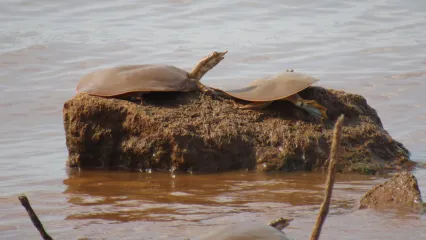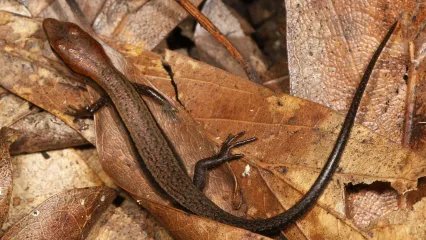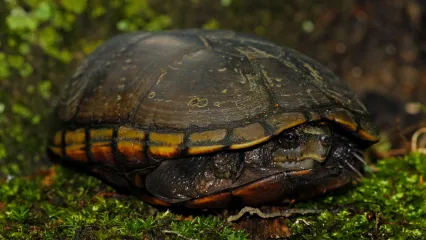
Description
The two species of softshell turtles (spiny and smooth) can easily be distinguished from all other turtles in Oklahoma by the total lack of scutes on the shell. Shells are relatively smooth and leather-like, except that the spiny softshell has distinct spines at the front and back of the shell. Edges of the shell are flexible. Webbing on feet is complete and the snout is long and thin. The nasal openings of spiny softshells have small ridges projected toward the center. Consequently, the openings are not completely round as in the smooth softshell.
Size
Adult females can reach 17 inches in carapace length whereas males are much smaller, reaching only about nine inches. Hatchlings are about an inch and a half in carapace length.
Habitat
Spiny softshells have a wide distribution in North America, extending nearly continuously west to east from Oklahoma through western New York with additional populations in the Colorado and Rio Grand River systems in the west. They occur in the Missouri River drainage from central Montana in the north to the Gulf Coast and south through Texas and into Mexico.
Life Cycle
Spiny softshells are totally aquatic and are most common in rivers, streams, and lakes. They deposit clutches of 3-40 eggs once or twice each season in sandbars from late May through July. Hatchlings appear in August and September. Although spiny softshells are omnivorous, their diets consist mostly of insects and aquatic invertebrates, such as crayfish and snails.
How To Observe
These turtles can often be seen basking on sand banks in streams and beaver dams in ponds that are connected to waterways. At a distance, spiny softshells are difficult to distinguish from smooth softshells. They can occasionally be found by walking in stream bottoms when water is low and searching in pools. They are common in most permanent streams and lakes, but often remain hidden under the sand. By remaining stationary for five to ten minutes and carefully searching the surface of the water in shallow areas, an observer can see their heads when they project them out of the sand and to the water surface to breath. Softshells are powerful swimmers, can run rapidly on land, and have sharp beaks and powerful jaws. They should be handled with car by gripping at the back of the shell.
(This profile was created by Dr. Laurie Vitt as part of a partnership between the Wildlife Department and the Sam Noble Oklahoma Museum of Natural History. It was funded as part of a larger State Wildlife Grant to survey and inventory amphibians and reptiles of the Wildlife Management Areas of Oklahoma: T-35-P-1.)


